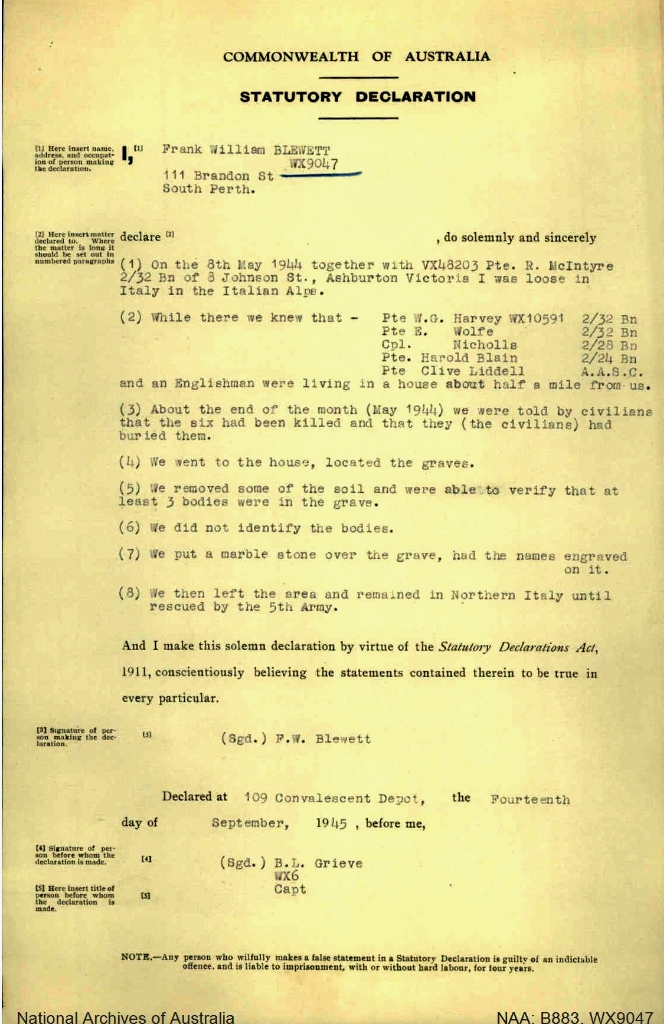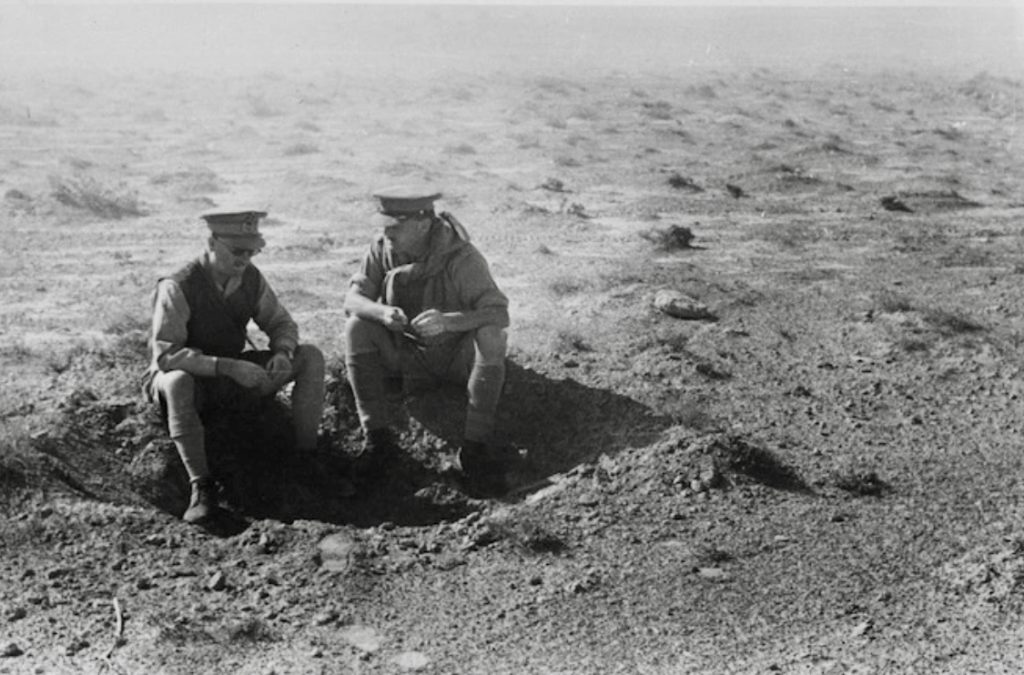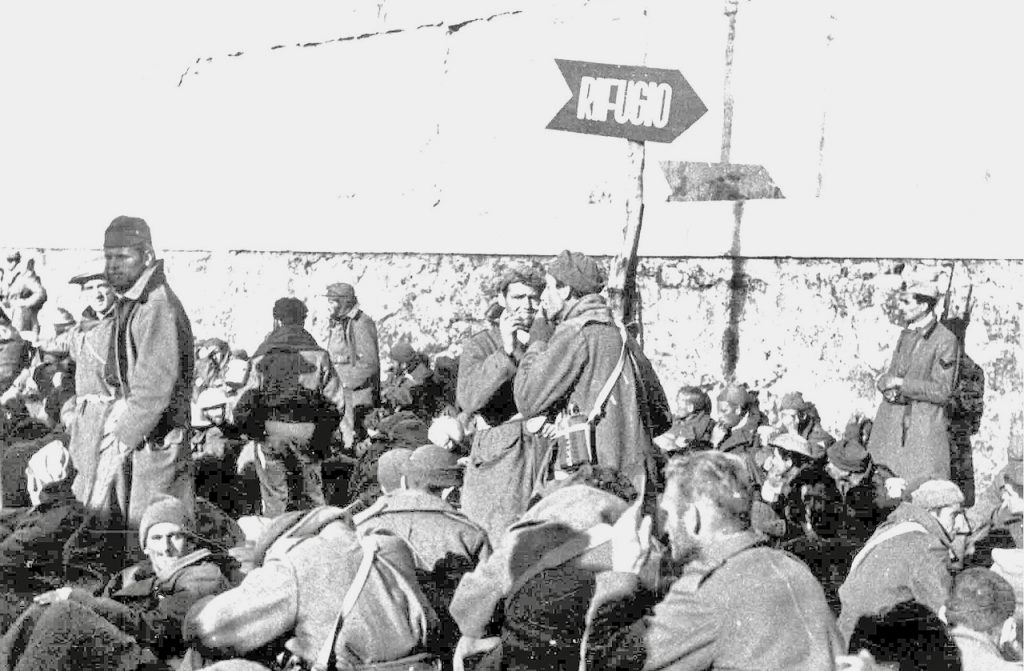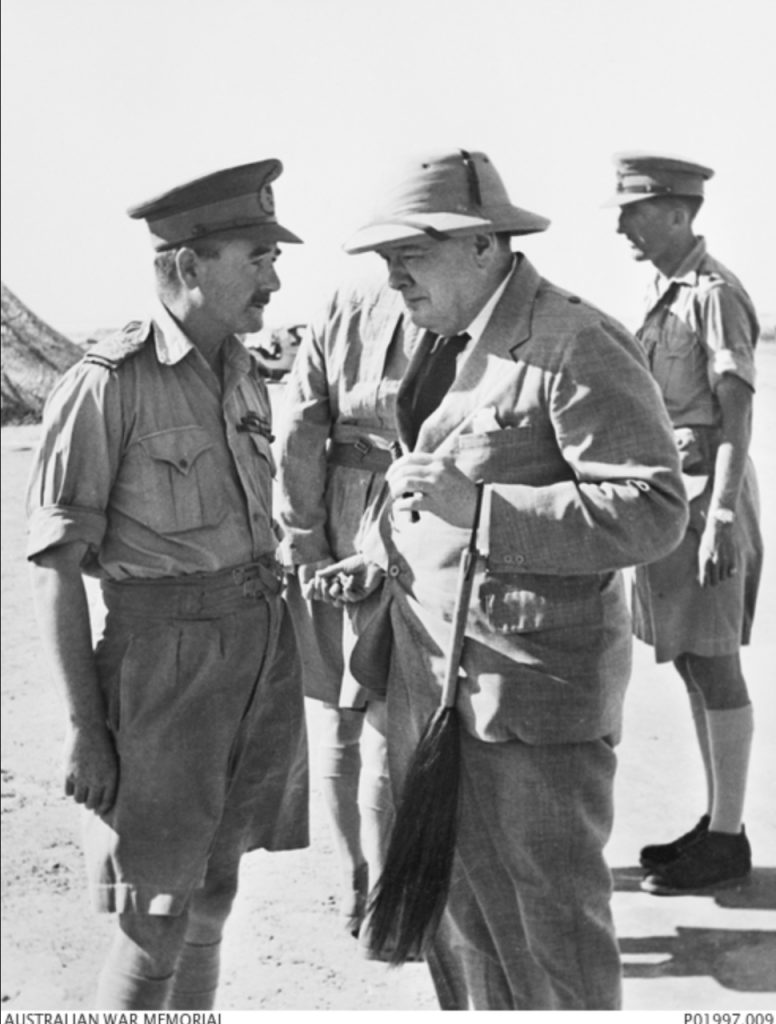Did you know about 7,000 Australian soldiers became POWs of Germany & Italy in WW2
Mostly captured Greece and Crete
and Incarcerated throughout Italy
The majority were captured during the ill-fated Greece and Crete campaigns of April to June 1941. The men were airmen and soldiers of 6th, 7th and 9th Divisions. Most remained captive for more than three years enduring cold, hunger, soul-destroying and never-ending boredom and sometimes physical brutality in Italy and later Germany.
Whilst researching 2/4th’s WX8631 Samuel James BLEWETT I discovered his older brother Frank William Blewett WX9047 2/32nd Battalion 9th Division was captured 22 Jul 1942 at the first battle at El Alamein.
Sam Blewett was not sufficiently fit to leave Singapore Island with work parties as he suffered chronic asthma.
You may like to read further about Sam Blewett.

We wish to acknowledge this map has been copied from History Guild https://historyguild.org/first-battle-of-el-alamein-australia-holds-the-line/
Sam and Frank Blewett were born at Gawlia. They were two of four children born to parents Samuel James (Snr) and Mary Blewett. At 37 years of age, in 1917 Samuel Blewett was killed at Sons of Gawlia mine. An Inquiry found another employee was responsible for Blewett’s death. Sam was a popular and well known football player, often captaining his local team. He had resided in the area since about 1901. His death left his wife widowed and his four very young children without a father.

Left: Sam Blewett, 2/4th MGB
Above: Frank Blewett
Australians captured in North Africa by Germany and Italty became prisoners of the Italians. Internment conditions in North Africa were terrible with little food & water provided. They were driven by trucks to Benghazi or Tripoli to board ships to one of several locations in Italy – Naples, Brindisi, Reggio Calabria risking attack by Allied Ships and aircraft while crossing the Mediterranean Sea.
So why did the Allies fail at the First Battle of El Alamein? A considerable degree of bumbling – was it because there were too many Nationalities?
https://www.awm.gov.au/sites/default/files/road_to_ruin_australian_war_memorial_svss_townsend_0.pdf
Please read NZ’s view of this First Battle of El Alamein
https://digitalcommons.liberty.edu/cgi/viewcontent.cgi?article=1059&context=ljh

Prisoners in pitiful state arrived in Italy having endured many months in North Africa on limited supplies around Tobruk and El Alamein and prior to sailing from North Africa where they received little food and drink by their captors while waiting. There was no opportunity to wash. The prisoners were often met by hostile crowds who jeered and threw projectiles which the Aussies happily returned.

Frank Blewett was initially sent to Campo 57 which held about 1200 Australians. This camp in north Italy had a chapel known as San Mauro or Grupignano
‘Italian camps varied greatly. Some were inefficient and badly run; others were easier. In September 1943 Italy surrendered. Some prisoners were able to escape to Allied lines in the confusion. Those unable to get away were rounded up and sent to Germany: prisoners for a further eighteen months.’ From AWM.
From Holdings Camps on the Italian coast Prisoners were entrained to one of numerous POW Camps throughout Italy. Campo 57 was located near Udine, in the Provence of Fruili in North Italy near the foothills of the Italian Alps. Prisoners were entrained to Cividale and then marched to their camp. Prisoners included Australians, New Zealanders, British, Indian and South African soldiers.
A special Corps known as Carabinieri governed POW Camps, they had both military and civil powers acting as a type of military police. Colonel Vittorio Calcaterra was Campo 57 Commander, a staunch fascist who inspired his men to treat the prisoners harshly, ration their food. Calcaterra liked to punish prisoners regularly for little reason locking them in punishment cells. Never brought to trial for his crimes, Calcaterra was killed by Italian partisans in 1943. It was said “Calcaterra delighted in doling out random beatings, clapping prisoners in irons, condemning them to solitary confinement for extended periods and reducing their rations.”
Still given a choice Australian POWs would have chosen Italy over Changi or Thai–Burma Railway or the Sandakan death marches. But captivity in Italy was not as ‘kindly’ as we have been led to believe. Colonel Vittorio Calcaterra, commandant of Campo 57 at Gruppignano and a committed fascist, was infamous among Australian prisoners for his brutality. He and his thugs inflicted cruel and degrading punishments on POWs, forcing sick men to stand on parade in sub-zero temperatures, and stripping, chaining, starving and beating other prisoners. He was deeply disliked by the POWs and locals!
Of course camp conditions varied.
Most camps received Red Cross parcels and mail regularly unless there were shipping problems, and in good times prisoners would receive one Red Cross parcel per week per man. They also received a good supply of clothing via the Red Cross acquired from various armies. (Frank was given a British uniform) Prisoners had to improvise medical treatment and feared ’57 twins’ – pneumonia and kidney disease. We know at least 10 Australians died at Compo 57.
‘When Italy surrendered to the Allies in September 1943, many prisoners escaped. Some reached Allied lines; others joined anti-Fascist partisans waging a guerilla war in Italy’s mountains. As many as 39 Australians who had been prisoners of war – no one really knows – died fighting with Italian partisans.
‘On 8 September 1943, news broke that Italy had formally surrendered to the Allies, with a secretly negotiated armistice agreement which included provision for the handing over of Allied prisoners in Italy. The War Office in London sent messages to the numerous camps that prisoners of war were to “stay put” pending the arrival of Allied forces.
German authorities, of course, were not party to this agreement and had no intention of leaving Italy, nor of allowing all those prisoners to be released to roam behind their lines. Several days of confusion followed before the German Army could move in to secure all the camps across Italy. In some camps pro-Fascist commandants or the senior Allied prisoner of war enforced the stay put order; in others the Italian guards just opened the gates and left, leaving the prisoners temporarily unguarded.
It is estimated that about 17,000 of the 70,000 Allied prisoners of war in Italy escaped from various camps during this period, including some 500 Australians. But at least 50,000 prisoners were transferred to Germany to endure another two years as prisoners of war. Much has been written of the failure by Allied commanders to plan adequately for the security of those prisoners or to take account of the inevitable German response.’ From AWM
‘Some Allied prisoners simply walked away, unchecked by the Italians who once had guarded them. That was the easy part; the hard part was finding a way to freedom, which often involved picking a way past Italian fascists, aggrieved by developments in the war and looking for violence, and through the German forces that had flooded northern and central Italy to defend the Gustav Line. Many escapers made for the Alps and tried to cross into neutral Switzerland; others went south in the hope of locating Allied lines and finding sanctuary behind them.
Fear and death stalked the men all the way to Switzerland or Allied lines, and they often went without food and shelter. If they reached the Alps they then had to cross them, challenge enough in peacetime. In civilian clothes behind enemy lines they forfeited the protection of the Geneva Conventions; capture could mean being declared a spy and executed. Some Australian escapers in Italy were murdered by Italian fascist soldiers. The physical and mental burdens incurred in “shooting through” were as heavy and damaging as those imposed by captivity. From ‘Shooting through’ by Katrina Kittel.

Above: Entrance to Camp 106
Below: Australian and New Zealand prisoners with Italian guard at Camp 106

Prior to Sep 1943 Frank BLEWETT had been moved to Camp 106. 106 was not a ‘regular’ POW camp – it was a cluster of work farm camps where prisoners worked in the surrounding rice fields 8 hours daily guarded by the Italian army – not as rigorously as most other POW Camps. With the surrender Italian soldiers left their posts and many prisoners were able to escape including Frank Blewett. The former prisoners headed for Switzerland or south intending to meet up with Allied forces. Some were captured, some were killed and thankfully many were successful. Frank didn’t reach Switzerland but hid in the lower Italian Alps until rescued by US 5th Army. He was sent to He sailed home to WA via UK arrived Sydney by ship May 1945.
The German army moved quickly to prevent the escaping prisoners – they did not want Allied troops roaming free behind their lines. The captured prisoners were then transferred to German POW Camps.
 Above: The main gate of Campo 57. About 1,200 Australians were held in this camp
Above: The main gate of Campo 57. About 1,200 Australians were held in this camp
We know from Franks AIF records he and another Australia soldier escaped and remained in the southern Italian Alps until rescued by US 5th Army.
Below: In Frank’s words he writes how he and another Australian prisoner were advised by locals 6 Australians and 1 English POW were killed in their ‘hideout house’ about a mile from Franks.

To read about the 1st Battle of El Alamein please go to following sites:
https://www.birtwistlewiki.com.au/wiki/2/32nd_Australian_Infantry_Battalion
https://www.awm.gov.au/articles/blog/1942-ruin-ridge
The following tells the story of an Australian POW who escaped camp who fought with partisans in Italy. https://www.coasit.com.au/images/ihs/journals/IHSJ_vol11_no1_2003.pdf
Below: Australian Morshead, Commander of 9th Division and New Zealand’s CO, believed to be Brigadier George Clifton, confer before battle. Clifton distinguished himself when as a prisoner he escaped.


Lt General Morshead
CO 9th Division AIF
He later won fame as the Defender of Tobruk.
Below: German and Italians taken prisoner by Allies advancing to El Alamein.

Below: Field Marshall Erwin Rommel with military aides.

Below: Australian and New Zealand prisoners waiting to be shipped to Italy 1942. It appears the weather is very cold – or were the prisoners forbidden to take belongings and decided to wear all they owned?

Below; L-R Churchill, Morshead & Britain’s General Claude Auchinleck Aug 42


Above: Morshead and Churchill
Below: Morshead with MacArthur – taken later in war when 9th Division had left Middle East.

EL ALAMEIN WAR CEMETERY AND THE ALAMEIN MEMORIAL There are 7,367 burials in the cemetery, of which 821 are unidentified by name.

Below: From AWM.
El Alamein, Egypt. 11 November 1943. Repatriated AIF prisoners of war (POWs) from German arriving to pay their respects to fallen comrades of the 9th Division at the El Alamein cemetery.


